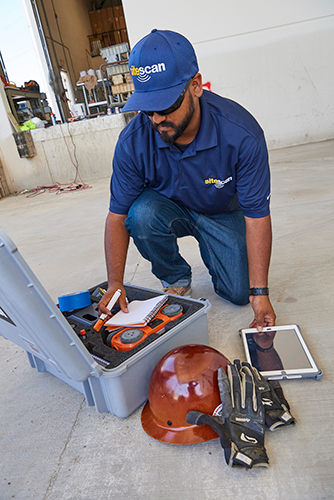Past the Surface Area: Leveraging Advanced Concrete Scanning Techniques for Unmatched Accuracy and Understanding
Advanced concrete scanning methods have emerged as crucial devices in this quest, supplying a peek beneath the surface to introduce a globe of vital insights. By using innovative innovations, experts can reveal anomalies, examine the problem of concrete frameworks, and make notified choices that form the program of projects.
Value of Advanced Concrete Scanning
The significance of utilizing advanced concrete scanning strategies hinges on the unequaled precision they offer for finding sub-surface anomalies and making sure architectural honesty. By using innovative modern technologies such as ground-penetrating radar (GPR), electro-magnetic induction, and progressed sonar imaging, building and construction professionals can dig under the surface of concrete structures with a degree of precision that much exceeds traditional assessment approaches. Concrete Scanning. These strategies make it possible for the identification of covert hazards like rebar rust, voids, avenues, or post-tension cables that could endanger the security and safety and security of a framework gradually
In addition, progressed concrete scanning gives indispensable insights right into the total condition of a concrete aspect without the requirement for invasive steps, lessening the threat of creating damage throughout the evaluation process. The capability to identify the specific location and deepness of potential problems permits targeted repairs and maintenance, eventually extending the life-span of the framework and optimizing its performance. In significance, the importance of advanced concrete scanning can not be overemphasized in the realm of construction and framework maintenance, where precision and dependability are vital.
Types of Cutting-Edge Technologies

Abnormalities and Issue Detection

Along with GPR, concrete scanning methods like thermography and impact-echo screening are likewise effective in finding anomalies and see this website defects. Thermography utilizes infrared modern technology to identify variants in surface area temperature, suggesting potential locations of issue such as delamination or moisture access. On the other hand, impact-echo testing includes evaluating acoustic actions to detect voids, cracks, and various other defects within the concrete. By leveraging these advanced strategies, specialists can proactively deal with structural concerns, guaranteeing the durability and safety and security of concrete frameworks.
Assessing Concrete Condition
How can engineers accurately examine the problem of concrete structures to guarantee their durability and safety and security? Analyzing the concrete condition is a crucial element of maintaining infrastructure stability. Various innovative concrete scanning methods are utilized for this objective. Ground-penetrating radar (GPR) is frequently used to evaluate the interior structure of concrete, discovering voids, fractures, and other anomalies that might jeopardize its toughness. Furthermore, impact-echo screening can give insights right into the density and stability of concrete aspects. Ultrasonic pulse speed screening is one more useful approach for reviewing concrete top quality by determining the rate of sound waves with the product.
Moreover, visual assessment stays an essential component of concrete condition assessment. Engineers aesthetically take a look at the surface for indicators of wear and tear, such as spalling, fracturing, or discoloration. Integrating non-destructive screening read more approaches with aesthetic evaluations permits a thorough evaluation of concrete problem, making it possible for engineers to recognize prospective problems early on and carry out timely maintenance or fixings. By leveraging these advanced techniques, engineers can make certain the lasting longevity and security of concrete frameworks.
Enhancing Decision-Making Procedures
In the world of framework administration, optimizing decision-making processes is vital for making sure the reliable upkeep and long life of concrete structures. Improved decision-making processes in concrete management include making use of innovative scanning methods to gather comprehensive information on the problem of structures. By leveraging technologies such as ground-penetrating radar and 3D imaging, stakeholders can make enlightened choices regarding support, fixing, or substitute approaches.
These advanced scanning methods give indispensable insights right into the inner make-up of concrete, identifying potential issues such as gaps, cracks, or corrosion that might not be noticeable externally. This level of thorough details permits proactive maintenance planning, minimizing the risk of architectural failures and increasing the total lifespan of concrete structures.
Moreover, by integrating electronic paperwork and analysis devices right into the decision-making process, stakeholders can track the advancement of concrete problems in time, making it possible for anticipating upkeep strategies and enhancing source appropriation. Eventually, the integration of innovative concrete scanning strategies enhances decision-making procedures by giving unequaled accuracy, understanding, and performance in facilities monitoring.
Final Thought
In verdict, progressed concrete scanning methods offer unrivaled precision and insight in discovering abnormalities, flaws, and examining the condition of concrete frameworks. By leveraging cutting-edge modern technologies, decision-making procedures can be boosted, bring about more enlightened and effective options for preserving and fixing concrete framework. These methods play an essential duty in making sure the safety and long life of concrete structures, making them an indispensable device in the field of construction and design.
Moreover, advanced concrete scanning supplies very useful understandings into the total condition of a sites concrete element without the requirement for intrusive steps, lessening the danger of creating damage throughout the assessment process - Concrete Scanning. Another innovative innovation is 3D X-ray scanning, which gives comprehensive photos of the internal framework of concrete, using important details without the demand for harmful screening. Furthermore, Concrete Cover Meters are made use of to measure the thickness of concrete cover over support bars properly. Improved decision-making procedures in concrete monitoring involve making use of advanced scanning strategies to gather detailed data on the condition of frameworks.In verdict, advanced concrete scanning techniques offer unparalleled precision and insight in detecting anomalies, flaws, and evaluating the condition of concrete structures